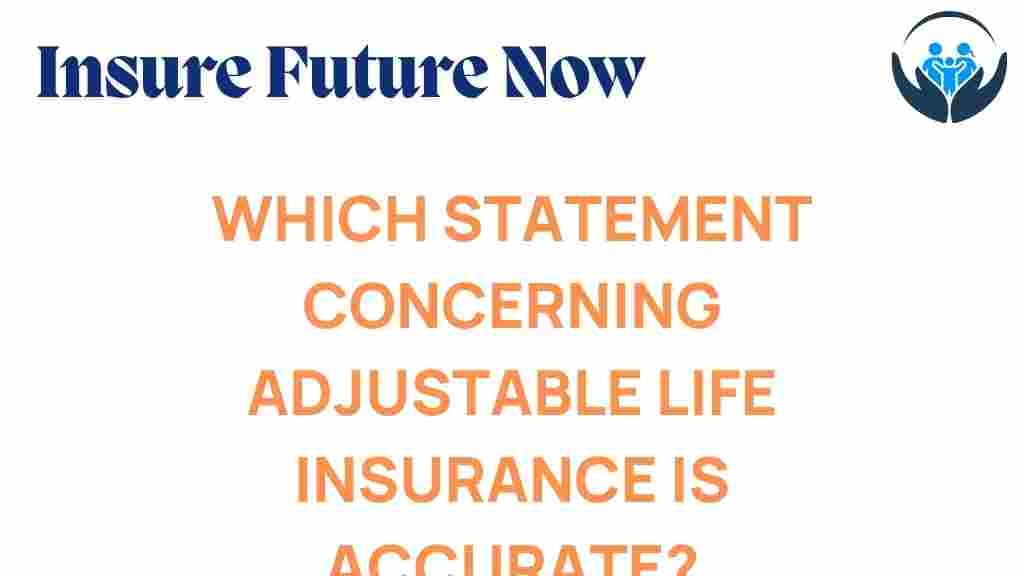Unveiling the Truth: What You Need to Know About Adjustable Life Insurance
When it comes to financial planning, life insurance is often a critical component. Among the various life insurance types available, adjustable life insurance stands out for its flexibility and adaptability to changing financial needs. However, many consumers are unaware of the intricacies involved in such policies. This article aims to shed light on adjustable life insurance, ensuring that you have the insurance accuracy necessary to make informed decisions. We will explore policy features, consumer awareness, and the different insurance options available, providing you with a comprehensive understanding of this unique life insurance type.
Understanding Adjustable Life Insurance
Adjustable life insurance is a hybrid policy that combines features of both term and whole life insurance. This type of policy offers the policyholder the ability to adjust premiums and death benefits over time, making it an appealing option for those looking for a flexible financial solution. Here are some key aspects:
- Premium Flexibility: Policyholders can increase or decrease their premiums based on their current financial situation.
- Adjustable Death Benefits: You can modify the death benefit amount, which can be advantageous as your financial obligations change.
- Cash Value Accumulation: Like whole life insurance, adjustable life insurance accumulates cash value, which you can borrow against in the future.
Policy Features of Adjustable Life Insurance
Adjustable life insurance comes with several features that make it distinct from other life insurance options. Understanding these features can help you determine if it’s the right choice for your financial planning needs.
- Flexible Premium Payments: You can adjust how much and how often you pay premiums, allowing for greater control over your budget.
- Adjustable Death Benefit: You can choose the level of coverage that suits your current needs, which can change as you age or as your financial situation evolves.
- Cash Value Growth: The policy accumulates cash value based on interest rates, which can be accessed through loans or withdrawals.
- Loan Options: You can borrow against the cash value, providing liquidity in times of need.
Financial Planning with Adjustable Life Insurance
When incorporating adjustable life insurance into your financial planning, it’s essential to assess your long-term goals and current financial health. Here’s a step-by-step process to help you navigate this journey:
- Assess Your Needs: Evaluate your current financial obligations, including debts, mortgages, and dependents’ needs.
- Determine Coverage Amount: Decide how much death benefit you require to cover these obligations adequately.
- Evaluate Premium Flexibility: Consider how much you can afford to pay in premiums now and how that may change in the future.
- Research Insurance Options: Compare adjustable life insurance policies from different providers to find the best fit.
- Consult a Financial Advisor: Seek professional advice to ensure that your choice aligns with your overall financial strategy.
Types of Life Insurance and Where Adjustable Life Fits In
Understanding the various life insurance types available can help you make an informed decision about adjustable life insurance. Here’s a brief overview:
- Term Life Insurance: Provides coverage for a specific period. It is usually cheaper but does not build cash value.
- Whole Life Insurance: Offers lifetime coverage with fixed premiums and cash value accumulation. However, it can be more expensive than term insurance.
- Universal Life Insurance: Similar to adjustable life insurance, it provides flexible premiums and death benefits with cash value growth.
- Variable Life Insurance: Allows for investment in various securities, affecting the cash value and death benefit based on market performance.
Adjustable life insurance falls between whole and universal life insurance, offering a blend of both flexibility and cash value growth.
Consumer Awareness and Insurance Accuracy
As a consumer, being informed about the intricacies of adjustable life insurance is crucial for achieving insurance accuracy. Here are some tips for enhancing your knowledge:
- Read Policy Documents: Always review the terms and conditions of the policy to understand your rights and obligations.
- Ask Questions: Don’t hesitate to ask your insurance agent about anything that is unclear.
- Seek Reviews: Look for customer reviews and ratings of insurance providers to gauge their reliability and service quality.
- Stay Updated: Regularly check for changes in policy features or regulations that may affect your coverage.
Common Troubleshooting Tips for Adjustable Life Insurance
While adjustable life insurance can be beneficial, some consumers may encounter issues. Here are some common problems and troubleshooting tips:
- Premium Payment Issues: If you struggle to make payments, contact your insurer to discuss options like payment plans or premium adjustments.
- Confusion Over Policy Changes: If you’re unsure about any adjustments made to your policy, request clarification from your insurance agent.
- Cash Value Access Problems: If you have difficulty accessing your cash value, ensure you understand the withdrawal or loan process outlined in your policy.
Conclusion: Making Informed Decisions About Adjustable Life Insurance
Adjustable life insurance can be a valuable tool in your financial planning arsenal, providing a balance of flexibility and security. By understanding its policy features, comparing different life insurance types, and staying informed about your options, you can ensure that you make sound financial decisions. Remember, the key to effective insurance planning is consumer awareness and insurance accuracy. Always do your due diligence and consult with a financial advisor when necessary. For further information, visit this resource to explore more about life insurance options.
In summary, adjustable life insurance offers the flexibility needed to adapt to changing financial circumstances. With a clear understanding of its features and the ability to navigate the complexities of life insurance types, you can secure a policy that meets your evolving needs.
This article is in the category Policies and created by InsureFutureNow Team
